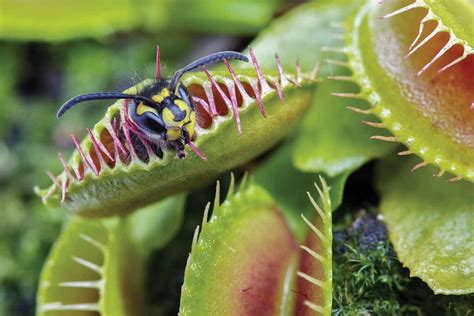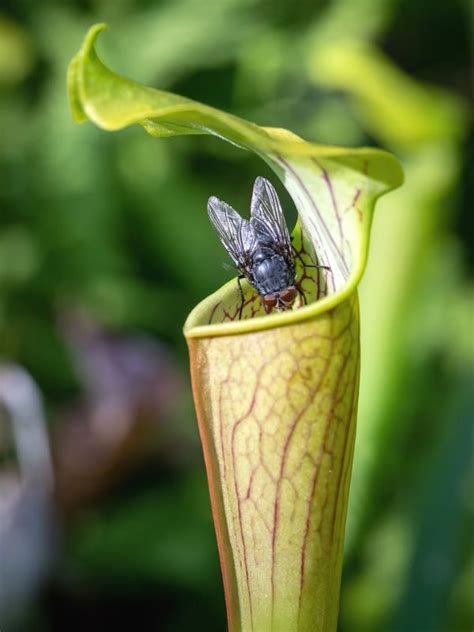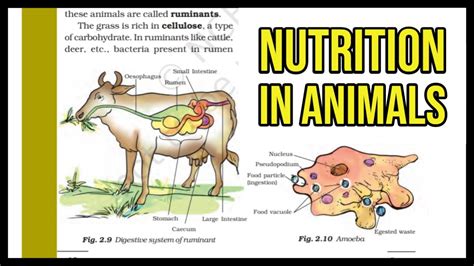Within the realm of botany, amongst the verdant landscapes, lies a secretive and enthralling group of plants: the captivating carnivorous plants. These peculiar organisms, so distinct from their herbivorous counterparts, have evolved a remarkable ability to capture, kill, and consume prey. With their unique adaptations and unusual feeding mechanisms, carnivorous plants have become a subject of fascination for scientists and nature enthusiasts alike.
One cannot help but marvel at the sheer ingenuity that these plants possess. To survive in nutritionally deprived habitats, such as acidic bogs or sandy soils, carnivorous plants have evolved a highly specialized strategy - devouring meat. Through a mesmerizing array of deceptive tactics, they lure unsuspecting creatures, enticing them with vibrant colors, nectar-filled traps, and seductive scents.
The strategies employed by these meat-eating plants are as diverse as they are cunning. From snap traps and pitfall traps to sticky traps and suction traps, each species has honed its own unique method of capturing prey. The infamous Venus flytrap, for example, relies on rapid leaf closing to ensnare its victims, while the pitcher plant ingeniously uses a pitfall trap, luring insects into its slippery, fluid-filled receptacle.
Beyond their terrestrial exploits, carnivorous plants are also found in aquatic habitats, where they ensnare aquatic invertebrates or even small fish. With astoundingly modified leaves and appendages, these aquatic species exhibit a stunningly beautiful adaptation, glistening beneath the water's surface. Their aquatic adaptations are a testament to the remarkable ways in which plants have evolved to survive and thrive in even the most challenging environments.
Join us on an extraordinary journey into the secret lives of these captivating plants, and delve deep into the realms of their complex and awe-inspiring world. Through the exploration of their various types, habitats, and feeding mechanisms, we unravel the mysteries behind their evolutionary success and unearth the intricate interplay between predator and prey in the plant kingdom.
The Incredible Adaptations of Meat-Eating Flora

Within the captivating realm of carnivorous plant life, astonishing adaptations abound, enabling these unique botanical specimens to thrive in their specific environments. These remarkable organisms possess a range of extraordinary mechanisms and specialized traits that allow them to obtain crucial nutrients from unsuspecting prey.
One remarkable aspect of carnivorous plants is their ability to lure, capture, and digest insects and other small creatures. These plants employ ingenious strategies to attract their prey, often utilizing vibrant colors, enticing scents, and enticing nectar. Once ensnared, they employ a variety of traps, such as sticky webs or snappy jaws, to secure their meal and prevent escape. The intricate nature of these traps demonstrates the impressive evolution and diversity within the carnivorous plant kingdom.
Carnivorous plants also exhibit astounding physiological adaptations that enable them to make the most of their carnivorous tendencies. These adaptations include modified leaves that function as traps, digestive enzymes that break down prey, and even symbiotic relationships with bacteria that aid in nutrient absorption. Such specialized structures and relationships showcase the remarkable versatility of these plants in acquiring vital nutrients that may be scarce in their respective habitats.
The ability of carnivorous plants to adapt to a carnivorous lifestyle is not limited to physical characteristics alone. These plants also possess remarkable behavioral adaptations. For instance, some species are capable of adjusting their trap mechanisms in response to the size or energy content of potential prey. Others have the ability to detect and respond to the presence of emerging threats, allowing them to avoid damage and preserve their valuable resources.
Overall, the world of carnivorous plants is a truly mesmerizing and awe-inspiring one. Through their astonishing adaptations, these botanical marvels have carved out their own unique niche within the plant kingdom, showcasing the incredible diversity and ingenuity of nature's creations.
Exploring the Wide Variety of Meat-Eating Plants
Within the captivating realm of botanical wonders, a diverse array of flora exists that possesses a rather peculiar characteristic: they are carnivorous. These unique plants have developed a remarkable adaptation allowing them to consume insects and other small animals in order to supplement their nutritional needs. This enthralling section of the article will delve into the fascinating world of different types of meat-eating plants, showcasing their various strategies for capturing and digesting prey.
1. Pitcher Plants: One of the most well-known carnivorous plant groups, pitcher plants have their own ingenious method for luring their prey. These plants typically possess large, fluid-filled pitcher-shaped leaves that contain a mixture of digestive enzymes and fluids. Insects are enticed by the attractive scent and colors of the plant's "pitcher," and once they venture inside, they become trapped and subsequently digested.
2. Sundews: Sundews employ an entirely different strategy to capture their victims. These plants feature small, glandular hairs on their leaves that secrete a sticky, adhesive substance, resembling the morning dew. Unsuspecting insects become entrapped upon making contact with the sticky droplets, ultimately becoming immobilized. The sundew then excretes digestive enzymes onto its prey, breaking them down into nutrients.
3. Venus Flytraps: Although the name of this plant has been omitted from the title of this article, its fame cannot be overlooked. The Venus Flytrap is an enchanting carnivorous plant that operates via snapping its hinged jaw-like leaves shut when triggered by the slightest touch. This rapid closure captures insects within the plant's grasp, exerting pressure until digestion takes place.
4. Bladderworts: Moving into the aquatic realm, bladderworts are carnivorous plants that possess small, bladder-like structures with vacuum-like traps. These traps create a low-pressure environment, causing unsuspecting prey to be rapidly sucked in. Once the prey is caught, the bladderwort releases enzymes to break down the captured organisms and absorb their nutrients.
5. Butterworts: Butterworts rely on a unique adhesive system to capture their prey. These plants feature glandular leaves that excrete a sticky substance, effectively immobilizing any unfortunate insects that make contact. The prey is then slowly dissolved by enzymes secreted by the plant, allowing the butterwort to absorb the necessary nutrients.
6. Monkey Cups: Monkey cups, commonly known as tropical pitcher plants, are carnivorous plants that often have unique characteristics such as bright colors and intricate patterns on their pitcher-shaped leaves. Their enticing appearance, combined with the insect-attracting nectar they produce, lures unsuspecting prey into their clutches. Once entrapped, the captured insects meet their fate as they become submerged in the plant's digestive fluids.
These are just a few examples of the diverse and captivating world of carnivorous plants. Each type mentioned here has developed its own extraordinary adaptations, allowing them to survive and thrive in environments with nutrient-poor soil. As you continue to explore this enthralling topic, you will discover many more intriguing types of meat-eating plants, each with their own awe-inspiring mechanisms for capturing and consuming their prey.
The Unique and Intricate Trapping Mechanisms of Ensnaring Pitcher Plants

In this section, we delve into the captivating world of carnivorous flora and explore the extraordinary ways in which ensnaring pitcher plants ensnare their prey.
Ensnaring pitcher plants possess a truly extraordinary means of capturing their unsuspecting victims. These remarkable plants exhibit specialized adaptations that allow them to lure, trap, and ultimately digest their prey. This intricate trapping mechanism showcases a fascinating co-evolutionary relationship between the plants and the insects they prey upon.
One of the prominent features of ensnaring pitcher plants is the presence of modified leaves that form a unique structure known as a pitcher. These pitchers have an enticing appearance that attracts insects towards them, often resembling attractive shelters or sources of food. The deceptive nature of these pitcher plants allows them to exploit the curiosity and vulnerability of their prey.
As the unsuspecting insects venture into the pitcher, they encounter a slick and waxy surface that greets their tiny footsteps. This slippery texture, coupled with the plant's inward-curving walls, makes it nearly impossible for the insects to escape once they have entered the trap. The insects find themselves trapped in a new world, separate from the one they once knew.
Ensnaring pitcher plants have evolved specialized mechanisms to ensure the successful capture and digestion of their prey. Some pitcher plants feature downward-pointing hairs or scales inside the pitcher, creating an additional barrier for escape. These formidable obstacles prevent insects from crawling back out of the trap, sealing their fate within the clutches of the plant.
Additionally, ensnaring pitcher plants produce a solution within their pitchers that aids in the digestion of captured prey. This liquid, often containing enzymes and other digestive substances, begins breaking down the insect's body, extracting vital nutrients that the plant needs for survival. Through this mechanism, the ensnaring pitcher plant not only secures its food source but also enhances its own growth and development.
The intricate trapping mechanisms of ensnaring pitcher plants highlight the incredible adaptability of carnivorous plants and their remarkable ability to thrive in nutrient-poor environments. Studying these incredible plants allows us to marvel at the wonders of nature's ingenuity and serves as a reminder of the never-ending diversity and complexity found in the natural world.
Surprising Locations: Where Meat-Eating Vegetation Thrives
Exploring the diverse world of flesh-eating flora unveils a remarkable range of habitats where these extraordinary plants flourish. From mystical boglands to remote mountain slopes, carnivorous plants have adapted to unexpected and contrasting environments, making their presence felt across the globe.
The Nutrient Hunt: How Meat-Eating Vegetation Acquire Their Nourishment

Within the intriguing realm of flesh-eating foliage, a critical aspect lies in their quest for sustenance. These unique plants, distinct from the ordinary greenery, have evolved with extraordinary mechanisms to procure essential nutrients. Their fascinating feeding strategies involve ingenious adaptations that enable them to capture, digest, and eliminate prey, replacing the conventional reliance on photosynthesis. This section will delve into the intricate methods employed by carnivorous plants to obtain the vital sustenance they require for survival.
Capture and Entrapment Techniques
Unlike their non-carnivorous counterparts, these exceptional botanical wonders employ a diverse range of capture and entrapment mechanisms. Some species utilize sticky hairs or glandular structures, exuding viscous substances designed to immobilize unsuspecting insects. Others possess sensitive trigger hairs that, when brushed against by prey, trigger rapid closure of specialized appendages, rendering them trapped. There are also those that utilize elegant pitfall traps or snap traps, relying on lightning-fast movements to ensnare their prey. Ultimately, the purpose of these adaptations is to confine and immobilize potential sources of nourishment.
Digestion and Assimilation Techniques
Once captured, the nutrient-rich meal undergoes a remarkable transformation within these meat-eating vegetations. They possess specialized enzymes and digestive fluids that break down the captured victims, allowing the plants to extract the essential nutrients they require. This process may occur within specialized plant structures, such as pitchers, digestive glands, or even underground chambers. By dismantling their prey, these plants transform the organic matter into a digestible form, facilitating the absorption of vital nutrients that would be otherwise limited or unavailable in their natural habitats.
Adaptations for Nutrient-Poor Environments
The evolution of carnivorous plants has been driven by the necessity to thrive in nutrient-poor environments. These incredible botanical entities have adapted to outcompete their vegetative counterparts by evolving various strategies to augment their nutrient intake. In symbiotic relationships with specific microorganisms, some carnivorous plants acquire supplementary nutrients through absorption from these microorganisms. Additionally, certain species engage in mutualistic relationships with insects, benefiting from the nitrogen-rich excreta of their insect partners. These adaptions showcase the unique methods employed by carnivorous plants to fulfill their nutritional requirements in seemingly inhospitable habitats.
The Nutrient Chase Continues
Driven by an unforgiving environment, the hunt for sustenance remains a constant endeavor for carnivorous plants. This section has unveiled the captivating mechanisms by which these vegetative carnivores procure their nutrition in unconventional ways. Encounter after encounter, these extraordinary plants engage in a never-ending nutrient chase, adapting and evolving to maintain their survival. The next segment will delve deeper into the astonishing diversity and extraordinary adaptations found within the intriguing world of carnivorous plants.
Conservation Efforts for Preserving Predatory Plant Species
Preserving the existence of unusual and captivating flora that have an intriguing predatory nature is a topic gaining increasing attention. Efforts to safeguard endangered carnivorous plants are essential to maintain their delicate ecological balance and prevent their extinction.
The conservation work revolves around understanding the complex needs and habitats of these unique plants, which inhabit diverse climates and landscapes. Habitats ranging from wetlands to mountain regions provide homes for these rare species and require targeted conservation strategies to protect their fragile populations.
Conservation efforts for carnivorous plants involve the collaboration of scientists, botanists, and environmental organizations. Their collective aim is to preserve these fascinating plants by emphasizing education, research, habitat preservation, and the enforcement of protective legislation.
- Education: Raising awareness about the importance of preserving carnivorous plants among the general public, nature enthusiasts, and students cultivates a sense of responsibility and respect for these remarkable species.
- Research: Conducting comprehensive studies on the ecology, biology, and distribution of carnivorous plants is crucial in understanding their specialized needs and developing effective conservation strategies.
- Habitat Preservation: Safeguarding the natural habitats of these plants through the establishment of protected areas, national parks, and reserves helps maintain the crucial environmental conditions necessary for their survival.
- Protective Legislation: Implementing and enforcing laws and regulations that prohibit the collection, trade, and destruction of carnivorous plants are essential in combating illegal activities that can significantly impact their populations.
Conservation efforts require ongoing monitoring and adaptation as human activities, such as habitat destruction and climate change, pose significant threats to the delicate balance of carnivorous plant ecosystems. By prioritizing these unique species, we can contribute to preserving the awe-inspiring diversity of our natural world for future generations to appreciate and marvel at.
FAQ
What are carnivorous plants and how do they obtain their nutrients?
Carnivorous plants are a unique variety of plants that attract, capture, and digest prey, usually insects, as a supplement to their diet. They obtain their nutrients, mainly nitrogen and phosphorus, from the digestion of these animals.
Are Venus Fly Traps the only type of carnivorous plants?
No, Venus Fly Traps are just one type of carnivorous plant. There are many different species and genera of carnivorous plants, each with its own unique way of capturing and digesting prey.
How do carnivorous plants lure and trap their prey?
Carnivorous plants have evolved various mechanisms to lure and trap their prey. Some plants, like the Venus Fly Trap, have modified leaves that snap shut when triggered by the movement of an insect. Others, like the Pitcher Plants, have pitcher-shaped leaves filled with digestive enzymes that attract and trap insects.



